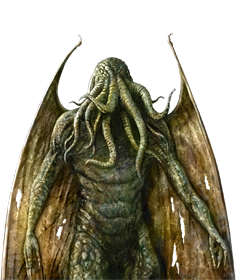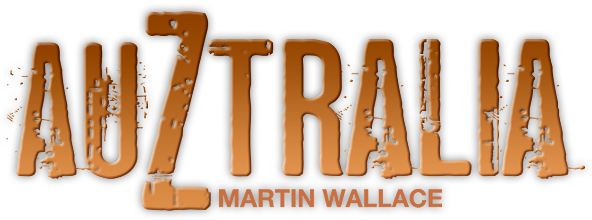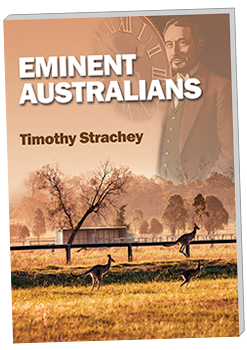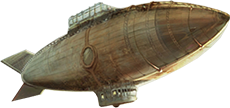
AuZtralia - the Back Story
A Study in Emerald saw the Old Ones banished from the northern hemisphere. But where did they retreat to? As explorers make their way into the Outback, the Old Ones awaken and a new battle for humanity takes place. AuZtralia is set in the 1930s in an alternative reality. Watch the video to find out more...

AuZtralia’s Personalities*
The thirty-six unique personalities in AuZtralia provide game changing skills and abilities. You won’t want to venture far without recruiting a few of these guys and gals.
Hover your mouse over each one to read their biography.
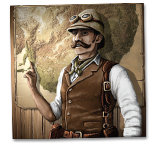
Agent Davies
(Born 1892 – died 1931)
Alun Davies was born in Pontypridd, Wales, the only child of Samuel and Bronwyn Davies. During the Restorationist war Samuel and Bronwyn were captured by forces loyal to the Old Ones and turned to ‘zombies’, (an Old One process to render the subject both pliable and almost everlasting). After the war Davies was adopted by Lord Caernavon, a famous explorer who was part of the expedition that discovered Australia. Davies learned much from his adoptive parent, which he turned to good use in helping to explore the vast ‘Outback’. His last action was to radio the position of the greatest of the Old Ones, Cthulhu himself, before disappearing, presumed killed in action.

Alanza Castro
(Born 1904 – died 1932)
For many years after the defeat of the Old Ones the Caribbean was plagued by horrific creatures that would strike at islands randomly. A rapid reaction force was formed to deal with this threat, one that has successfully protected the citizens of those islands since then. Alanza Castro joined this force at the age of sixteen, after her family was wiped out by one such attack. She soon acquired a reputation as a tough fighter, one who would never back down against whatever creature she faced. Her tenacious fighting skills were felt to be perfect to help defend the settlers of Australia and she was recruited to join the military there. She gained posthumous renown by her stubborn defence at the battle of Wemba Wemba, where her unit was overrun by three shoggoths.

Alexander Proust
(Born 1887 - )
Alexander Proust was born in Paris, just before the war started. His parents fled to relations in Versaille for safety when the war reached its climax in 1893. Proust became an apprentice at the Renault factory. His mechanical aptitude made him a valuable employee and one who contributed many ideas and improvements to Renault’s vehicles, especially their armoured cars. Proust was seconded to the armoured car division that was sent to Australia, where he did critical work on maintaining and improving the vehicles to make them more effective against the Old Ones. He returned to France in 1933. He retired in 1952 after reaching the position of chief engineer of Renault.
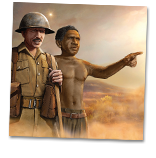
Billy Kneebone
(Date of birth unknown)
The first Westerners to reach the shores of Australia were welcomed by the inhabitants of that land, the people we now call the Koori. The Koori already had knowledge of the ‘people from beyond’ as they called us. Tales have since emerged of some sailors, presumably Dutch, being shipwrecked in Australia many years ago. These survivors apparently helped the Koori to resist the Old Ones and became renowned heroes, whose tales were passed down from generation to generation. Billy Kneebone, as his name translates, was one of many Koori who welcomed the Westerners as allies against the Old Ones, who still haunted their ancient tribal lands. He acted as a guide to our military forces, which allowed them to travel much further into the regions known as the ‘Outback’. Billy was elected as the mayor of Parramatta in 1948..
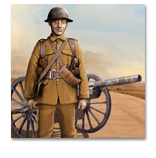
Bombardier Milligan
(Born 1902 - )
Harry Milligan’s parents emigrated to India from Ireland in 1885, where his father became a sergeant in the second Marathan Arillery Division. Milligan followed in his father’s steps and became a Bombardier in the artillery unit attached to the Australian expeditionary force in 1930. After the war he returned to India where he now plays trumpet in the Delhi Jazz Band..
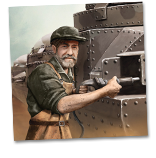
Boris Krupp
(Born 1879 - died 1950)
Boris Krupp was born in Essen in 1879. He joined the Essen Steel Company, one that previously bore his name despite not being part of that family. This may have been to his advantage as the Krupp family were notorious Loyalists and after the war many of them were executed or imprisoned for life. Krupp gained much experience in developing armour plating for vehicles, including trains. He was recruited to the Australia expedition to contribute his engineering skills to the maintenance of the civilian and military train stocks. He retired in 1935 due to poor health.

Captain Flounder
(born 1855 – died 1932 )
James Flounder had sailed three times around the world before he reached the age of fourteen. His father was captain of a merchant vessel that traded between Britain and Japan. Flounder joined the Restorationist Japanese Navy during the war against the Old Ones, rising to the rank of First Officer. After the war Flounder returned to the merchant services, gaining command of his own ship. During the settlement of Australia Captain Flounder risked storms and more unworldly dangers to bring vital military supplies to the colonists. His ship was wrecked off the Southern coast of Australia in 1932, with the loss of all hands.

Colonel Khouri
Zaina Khouri was born in Beirut in 1902. She was thrown into the world of warfare after her family were massacred by irredentist forces loyal to the Old Ones. Khouri joined the resistance to the infamous Lawrence regime. By the time of their defeat at the Siege of Jerusalem, Khouri was recognised as an outstanding military commander. It was only natural that she was chosen to command the protection forces sent with the first pioneers to Australia. Khouri was seriously wounded at the Battle of Parramatta and returned to the Lebanon. Since then she has been a reclusive figure, living with her childhood companion, Mazia Haddad, on the shores of the Mediterranean.
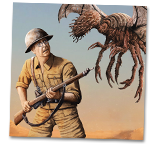
Corporal Jones
(Born 1869 – died 1950)John’ Jack’ Jones was born in 1869 in Walmington-on-Sea. His father was a butcher. Jones ran away to sea at the age of fifteen. During the Restorationist War he fought with the forces of Muhammad Ahmad and was wounded at the Battle of Cairo. When the call went out for volunteers to settle Australia, Jones was one of the first to sign up, despite his advanced age. His knowledge of the Old Ones, gained from painful experience in North Africa, was regarded as being of great use, especially his ability to somehow know when to run away.
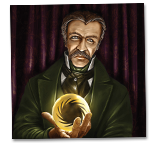
Count Jago
(Born 1641 - )Stefan Jago was born into the notorious Jago family of Transylvania. His uncle, Josep, was infamous for carrying out cruel and unusual punishments on behalf of the local Old One rulers. The young Stefan showed an aptitude for alchemy and ‘magic’ and was inducted into the Brotherhood of Yog-Sothoth. Jago eventually became the magister of Transylvania after the death of his uncle in a mysterious accident. As a reward for loyal service Jago was granted immortality by the Old Ones. However, during the Restorationist War, Jago switched sides and joined the forces of humanity, helping to rid Transylvania of its terrible masters. His deep knowledge of the ways of the Old Ones helped humanity fend off the madness that occurs when you come into contact with them. This proved to be of immense value to the Australian expedition, where his insights into the enemy helped win a number of battles. Since the war for Australia he has retired to his castle in Transylvania, returning to his studies of the texts of the Old Ones.

Dagmar Krauss
(born 1881 - )
Dagmar Krauss was born in 1881 in the Austrian city of Linz, into a prosperous farming family. Krauss studied agriculture at the University of Vienna. A lot of Austrian farm land was devastated after the Restorationist War and Dagmar spent many years repairing the damage to her family’s estate. Krauss volunteered to join the Australian expedition to bring her experience in establishing farms of all types to the new continent. To date she is still working in Australia to improve farming techniques.

Desta Danger
(born ?)
We have very little information on the early life of Desta Danger. We know that this is not her real name and there are theories that suggest she is the granddaughter of Simeon Khumalo, the first President of Zimbabwe, elected after the Restorationist War. Khumalo and his family were massacred by guerrilla loyalists in 1915, although not all of the family were accounted for. Danger obviously picked up numerous skills over the years hiding from Loyalist assassins to make her a formidable fighter. Recruited by Kitchener in 1927, she sailed to Australia in 1930. Her most famous exploit during the war against the Old Ones was the single-handed destruction of the Temple of Olkoth, thus saving the local settlers from the horrors that were in the process of emerging from the portal within. Since the end of the war, Danger has carried out numerous surveys of the interior of Australia.

Donald McDonald
(Born 1879 – died 1949)Donald of the clan McDonald was a life-long philanthropist, giving away a significant portion of his estate to help good causes. McDonald was very supportive of the Australia expedition, donating both money and resources to the venture. After dissipating his vast fortune he was forced to move to North America in 1939 to join his brother in a business venture connected with ready-to-eat meals. He died of a sudden heart attack in 1949.
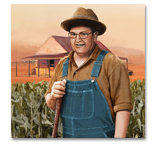
Ferdi Cassan
(born 1882 –)
Ferdinand Cassan was born in Vienna, Austria. His father was an expert in agriculture, who specialised in the cataloguing of seed lines. Ferdinand followed in his father’s footsteps. His knowledge of a wide range of plants and cereals was invaluable when it came to finding which ones would grow best in Australia. Cassan soon found that the soil was not so suitable for wheat and suggested that corn be the main crop. He was also instrumental in studying the indigenous flora of Australia and identified a number that have now become important food sources.
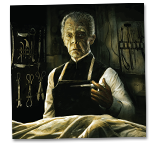
Franz Neumann
(born c1831 )
Neumann was born in Munich, Bavaria and studied medicine at Heidelberg university. It is presumed at this time that he was inducted into the Cult of Yog-Sothoth. He gained the trust of the Old Ones and was allowed to learn some of the secret methods to bring the dead back to life and to extend life spans. During the Restorationist War he fought for the Loyalists and was captured during the Battle of Berlin. He was released from prison in 1927 on condition that he join the expedition to Australia as a doctor and specialist in the Old Ones. Any earlier sins were redeemed by his support of our military forces, saving literally hundreds of lives. He now resides in Beerburrum, where he still practices as a doctor.
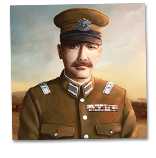
General Takanashi
(born 1888 – died 1932)
Akira Takanashi was born in Hiroshima. His father fought for the Loyalists in the Restorationist War. After their defeat he committed seppaku. Takanashi was driven by the need to restore honour to his family’s name. He joined the Japanese army at sixteen and through hard work, determination and talent became the youngest serving general in 1929. Takanashi was seconded to the Australian expedition to command the allied forces. He was a commander who enjoyed leading from the front, which had fatal consequences when he died leading an infantry charge at the Battle of Wagga Wagga.

Harry Bones
(born 1880 - died 1948 )
Harry Bones was born in Pontypridd, Wales. After the Restorationist War he was employed by the local coal mine. He also took evening lessons in mathematics and engineering. These qualifications allowed him to advance his career and he eventually became the chief mining engineer. In 1915 he became caught up in the violent clashes at Tonypandy, where a Loyalist movement was raising forces to challenge the government. His brother, Dai, was responsible for killing the Loyalist leader, Winston Churchill. Bones was asked by Kitchener to join the Australian expedition to help develop the mining skills of the settlers to better take advantage of the natural resources of Australia. He returned to the valleys of South Wales in 1942 and passed away in his bed in 1948.
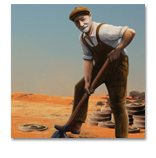
Ivan Karpov
(born 1888 – died 1932)
Ivan Karpov was born during the Siege of St. Petersburg, where the Restorationists held out against the Loyalist forces of Count Schliefen for over two years. After the war, Karpov joined the army and became an expert in the design and deployment of landmines. These skills were highly valued for the Australian expedition. Karpov’s minefields at Wallaroo were instrumental in defeating the Old Ones that attacked there in 1931. Karpov unfortunately did not live to see the final defeat of the Old Ones, losing his life when a store room containing land mines exploded.
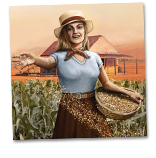
Jenny Appleseed
(born 1898 - )
Jenny Appleseed’s parents moved to the lands of Montana in 1886. During the Restorationist War much of the local farming land was blighted by shoggoths. Jenny’s parents spent years experimenting with ways to cure this blight, a venture that they eventually succeeded in. Jenny followed in her parent’s footsteps to become a farmer and an expert in dealing with blights. She was recruited to the Australian expedition to share this knowledge with the settlers. Appleseed took to the new lands of Australia and established her own farm in the lands around Ballarat. She resides there today with her family.
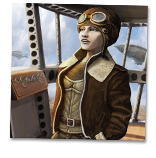
Juliet Verne
Verne was born Nantes, France, to Michel and Valerie Verne. Her father was a pioneer of airship technology. His death in the Restorationist War, while piloting an airship against the Old One known as the ‘Spinner in the Darkness’ greatly affected her and led to her being the first female airship aeronaut. Verne had many narrow escapes while scouting the interior of Australia, once having to trek over 800 miles through the outback after her airship crashed while attempting to destroy an Old One temple. Verne’s grandfather, a lawyer by profession, was also known as an amateur author who penned an amusing work on an alternative history of the world, one that was never ruled by the Old Ones. However, this form of literature never took off.
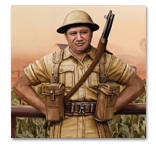
Kapena Alika
(born 1896 - )
Samoa. The Pacific Islands were the border of known civilisation during the reign of the Old Ones. No human was allowed to sail south from these islands, thus maintaining the secret of Australia. Many of Kapena’s ancestors served the Old Ones in policing the seas of the Pacific. During the Restorationist war Kapena’s grandfather originally fought for the Loyalists, but then changed sides after witnessing the atrocities carried out by the mutant forces of Doctor Moreau. The Islanders rose up against the Old Ones and added their strength to that of the Restorationists. Kapena Alika had heard about the settlement of Australia and made his way there independently of the main convoy. Once here he proved himself an able commander of the Rapid Reaction Force, which was formed to quickly respond to imminent attacks on farming settlements. Kapena survived the war and eventually settled on the coast of Australia, becoming a fisherman.

Kitchener
(Born 1855 – Died 1940)
Algernon Kitchener was the younger brother of Horatio Kitchener, who achieved notoriety during the Restorationist War for the Thetford massacre. Unlike his brother, Algie (as known to his friends) fought on the side of the Restorationists. He was an outstanding recruiter, bringing many hundreds of volunteers in to fight against the Old Ones. He was asked by the British government to apply these skills as the Australian expedition was being formed. Kitchener toured the known world searching out people of talent to help support the Australian venture. He retired to his estate at the end of the war. Horatio Kitchener joined the Old Ones in Australia and was killed at the Battle of Wagga Wagga.

Lady Carter
(born 1890 - )
Lady Elizabeth Carter is the last remaining member of the Carter family. As she remains unmarried on her passing the glorious Carter name will pass into history. Her maternal grandfather, Hillary Carter, was the leader of the mission to destroy the Egyptian pyramids, thus removing a source of power for the Old Ones. His heroic death at the Pyramid of Giza is well-known to young and old. The Carter estate includes many coal mines. Lady Carter was most generous in donating many thousands of tons of coal to the Australian Expedition, to help power the locomotives until local sources could be mined.
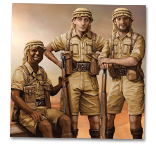
Long Range Outback Group
The Long Range Outback Group was the brainchild of Major Silver. Using a range of modified cars and trucks this group ranged far beyond the settled areas, searching for the Old Ones and assaulting them in a series of hit-and-run attacks. A number of Koori volunteered to join the group, whose knowledge of the Outback was invaluable in navigating the uncharted hinterland.
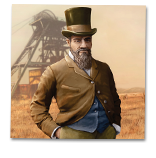
Lord Blackstock
(born 1865 – died 1942)
Lord Blackstock’s father emigrated to the southern provinces of Africa in 1854 from his estates in Cornwall. Here he established a number of highly productive gold mines, becoming one of the richest citizens of the continent. The present Lord Blackstock inherited these riches when his father was executed by the Old Ones on suspicion of conspiracy. Blackstock’s hatred of the Old Ones led to him using his immense wealth to fund various factions of the Restorationists in their struggle against the Old Ones. He also contributed significantly to the settlement of Australia.
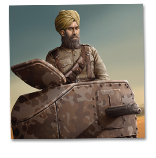
Lt Singh
(born 1899 – died 1932)
The Sikh families of the Punjab have a long and glorious history of resistance to the rule of the Old Ones. Javan Singh was born into a culture that prepared him to be an outstanding warrior, one who would fight against the Old Ones until his dying breath. There were still many groups and factions who remained loyal to the Old Ones after the end of the war in parts of the Indian sub-continent. Javan spent many of his early years in the army fighting against these forces. He volunteered to join the protection force sent to Australia, where his aptitude for mobile warfare was recognised in his posting to the Light Armoured Division. Javan Singh lost his life along with many others in his company at the Battle of Wagga Wagga.

Mad Johnson
( born 1864 - )
William ‘Mad’ Johnson is famed as one of the greatest hunters of all time. His adventures in South America gained him the additional moniker of ‘Mad’, where he spent three years tracking down the last of the giant Jaguars (once pets of the Old Ones). He travelled to Australia in 1915 and immediately set out for the Outback. Nerves of steel and a lucky streak that defies the laws of probability saw him amass an incredible number of kills of zombies, Mi-Go and even a Shoggoth. He now lives in retirement near Basildon, England.
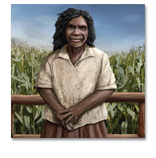
Merinda Sweet
(Date of Birth unknown - )
Since the defeat of the Old Ones in Australia much has been learned of the history of the Koori and other indigenous groups. Up until the arrival of the Old Ones they seem to have lived as hunters and gatherers. The Old Ones interrupted that lifestyle and some tribes developed forms of settled agriculture to survive, away from the haunted areas. When the first settlers reached Australia they first tried raising crops of wheat, but the soil was not suitable. Koori farmers such as Merinda Sweet (as referred by the settlers) helped the first farmers to understand the soil and which crops would work best. Corn was found to be an excellent crop, quickly spreading along the eastern seaboard.

Luigi Caprotti
(born 1876 - )
Luigi Caprotti was born in Turin, Italy. At fourteen he became an apprentice to the locomotive manufacturers Gio. Ansaldo & C., leaving his family home and moving to Genoa. He and his family moved with the first wave of settlers to Australia, where he was employed in helping maintain the fleet of locomotives. During the struggle with the Old Ones he turned his years of experience in fixing trains to helping repair armoured cars, airships and artillery pieces. Caprotti and his team of engineers would work through the night to maintain the forces opposing the Old Ones. As such Luigi is one of the unsung heroes of the War for Australia. He survived the war and now enjoys the life of a retired person in the town of Toowoomba.
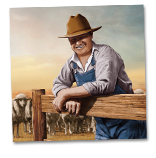
Mr Merino
(born 1874 – died 1931)
The Merino family trace their ancestry back to Spain and have a long association with raising sheep of the same name. Benjamin Merino was part of the first wave of settlers to reach Australia. He was instrumental in developing sheep farming in the interior. This helped produce both supplies of meat and wool. What happened at the Merino farm in October 1931 is still a mystery, there being only a large crater where the family house used to stand. Photographs of the thousands of dead sheep littering the surrounding pastures speak of the power of destruction of the Old Ones.
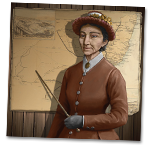
Mrs Bradshaw
(born 1870 – died 1948)
Jemima Bradshaw was born in Leeds in 1870 to a working-class family. A brilliant student at school she won a scholarship to Cambridge University, studying mathematics. After graduation she gained employment with the LNER, where she became an expert on timetables. Her ability to efficiently manage complex railway networks made her the obvious choice for managing the new railway systems of Australia.
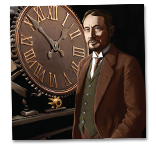
Professor Guyonne
(born 1880 - )
Felix Guyonne’s home town of Geneva has a long association with the history of time pieces and Guyonne’s family background was in watchmaking. However, Felix became more interested in the philosophical and scientific understanding of the nature of time. He was elected a professor at the University of Geneva in 1920, and was recognised as the leading expert on the nature of time and the technology used by the Old Ones to shift and warp time. It was this knowledge that made Guyonne a valuable member of the Australian Expedition. With technology barely understood today, he was able to manipulate time so that our forces were able to move ‘faster’, thus reacting to the advances of the Old Ones in time to defeat them.

Tex McGuire
(born 1889 - )
Ted ‘Tex’ McGuire was born in the Mexican state of Texas and is of Irish ancestry. McGuire inherited a Longhorn cattle ranch from his uncle, in fact one of the largest in the state. His knowledge and experience of raising Longhorns in a difficult environment fitted him perfectly for the role of livestock consultant to the Australian expedition. As well as shipping some of his own stock to the new continent, Tex advised other farmers and carried out breeding programmes to improve the stock. After the war he retired to his ranch In Texas.
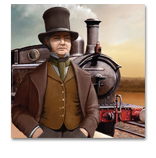
Timothy Brassey
(born 1882 - )
The grandson of Thomas Brassey, a major figure in the creation of the British rail network. Timothy followed in the footsteps of his illustrious grandfather, becoming a renowned railway engineer and project manager. Timothy’s talents were invaluable in helping develop the railways of Australia. Brassey was faced with many new challenges such as the extreme temperatures of the Outback which meant adapting the laying of the rails to cope with increased heat expansion. It was also necessary to develop special ‘Cow-catcher’ devices to deal with the occasional dead Mi-go on the line.

Yvette Quilla
(born 1891)
The Quilla family established their iron foundry in Fresnoy-le-Grand (the Aisne) in 1795. By the end of the nineteenth century the Quilla works was the largest producer of iron and steel in Europe. Yvette Quilla, the eldest daughter of the then family controller, Ernest Quilla, was instrumental in arranging major shipments of iron rails to Australia to help build the track that the settlers so desperately needed to penetrate the interior of the country.
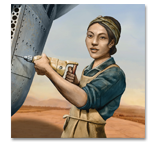
Zhu Xiang
Zhu Xiang was born in Beijing, China. After the Restorationist War her parents were assigned to the Chinese Cultural Office in Paris. Zhu enrolled at the École Normale Superieure to study engineering. While here she became friends with Juliet Verne. This led to a fascination with airship design. When Verne was enrolled for the mission to Australia, Xiang accompanied her as her chief engineer. Xiang’s modifications to the expedition’s airships made them more rugged and better able to handle the conditions of the continent. Zhu Xiang returned to China at the end of the war and now runs the Chinese airship research program.
Published in 1954, ‘Eminent Australians’ was one of the first books to record the background and lives of some of the more significant personalities responsible for saving human kind by the successful settlement of Australia and the final defeat of the Old Ones.
You can download our special PDF edition of Eminent Australians
right here by clicking the cover on the left!
